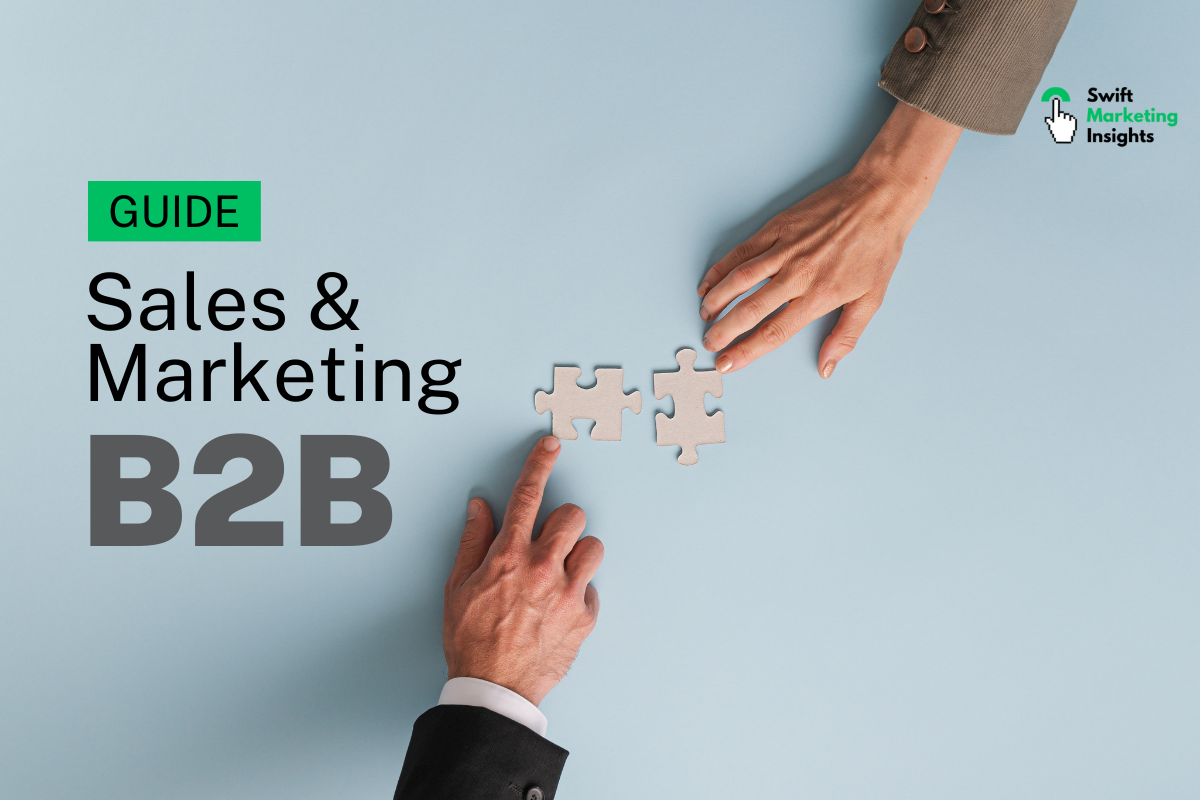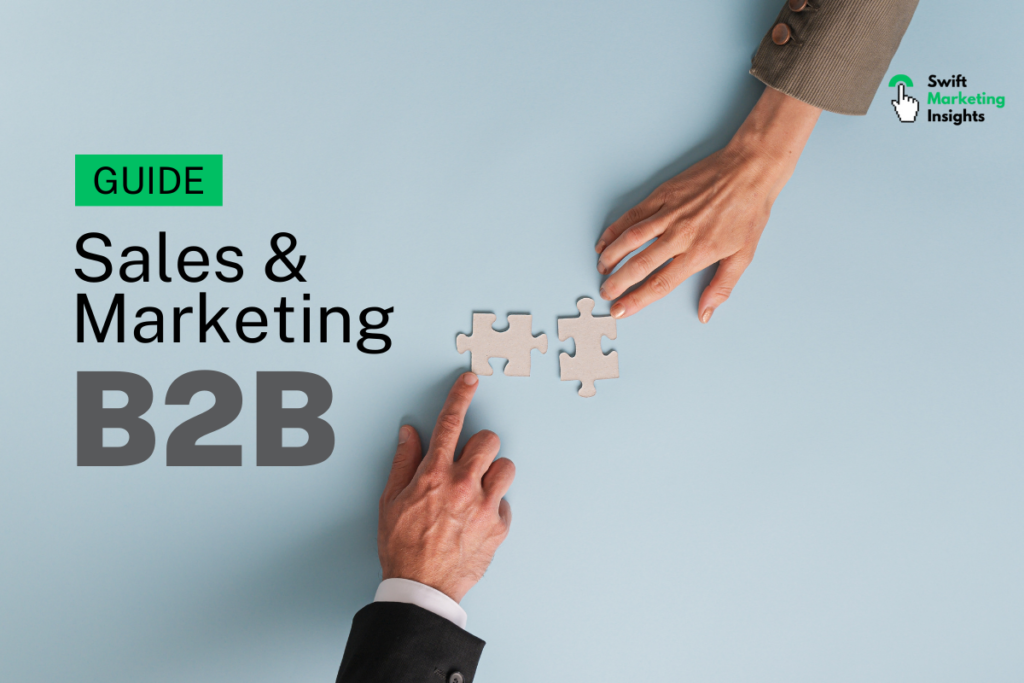

B2B players face a range of challenges preventing true realization of their sales and marketing objectives in the face of the present day’s intense competition. Maximizing B2B Sales and Marketing Potential: The Ultimate Guide provides a roadmap to navigate these complexities. To achieve superior performance and profitability, adapting new successful strategies that are timely is required as well as overcoming constantly changing customer expectations, new technologies and the whole market dynamics.
Understanding B2B Sales and Marketing
Before getting to the point of strategies, it is critical to understand the basic principles of B2B sales and marketing. B2B sales and marketing denote the interbusiness transactions of products, provision of services, or information in a business-to-business environment, without any corporate customers. So, this sales funnel is distinguished by the most extended sales cycles, the most complex decision-making processes, and a high rate of focus on the long-term relationship building.
One of the major points of differentiation between B2B (business-to-business) sales and marketing and B2C (business-to-consumer) sales and marketing is the target market. B2B buyers, in contrast, are mostly sophisticated, proven, and have their attention on the value that promises to support the achievement of their unit objectives. Besides that, B2B contracts oftentimes relate to big projects and higher risk levels that following only an interesting conversation is not enough – a proactive and problem-solving approach is required.
While navigating through the B2B terrain, we cannot neglect the trends and challenges that are typical for this dynamic environment. Several remarkable trends may be noticed such as the implementation of digital technologies, the growing popularity of ABM (account-based marketing) and the augmented significance of data-powered decision-making. Issues handle procedures such as complex bidding processes, dealing with multiple stakeholders, and revising buyer actions may be a major issue.
B2B Sales and Marketing Strategies
B2B sales and marketing strategies require a laser focus on building relationships and demonstrating value. It’s not just about generating leads, but nurturing them through targeted content and personalized interactions. Successful B2B teams align their efforts, with marketing providing qualified leads and sales delivering tailored solutions that address specific business challenges. Data and analytics play a crucial role in understanding customer needs and measuring campaign effectiveness. Ultimately, B2B success lies in fostering trust, establishing expertise, and delivering measurable ROI for clients.
Lead Generation
Efficient lead generation is directly the heart of every B2B sales and marketing strategy. It entails identifying and capturing the attention of those interested in your products or services – people who are potentially going to become your customers. The best B2B lead generation practices cover running special events and trade shows with your brand, website optimization, using the social networks to advertise your business, and gradual lead nurturing via personalized follow-up.Sales Funnel Optimization
The B2B sales funnel depicts the passage of a prospective customer from initial awareness until final purchasing. Bringing down the bottleneck is essential either for sales conversion improvement or for revenue maximization. Strategies to optimize the sales funnel include identification and remedy of the bottlenecks, provision of the legitimate content at each stage, utilization of tools automation to streamline process, and permanent analysis and changing the approach based on metrics performance and customer feedback.Marketing Automation
Marketing automation now can be counted among the major irreplaceable tools B2B companies use to systemize and optimize their marketing activities. Automation not only frees employees for more valuable activities but also ensures consistency and the ability to scale. By performing e-mail campaigns, lead nurturing, and social media scheduling among others, businesses can boost efficiency, consistency, and scalability. Principal markers used to develop marketing automation systems are lead scoring, lead nurturing workflows, campaign management and analytics and reporting tools.Content Marketing
B2B sales and marketing cannot be envisaged without content marketing since it solidifies the standing of thought leadership, builds trust, and assists in nurturing leads through the sales pipe. What is of the essence in making appealing content for the B2B audiences is to bear in mind the following: their pain points, challenges, and information needs. This can be done by collecting a lot of data, mapping out a plan for creating content, crafting content according to a buyer persona, and using a variety of content formats that include blog posts, whitepapers, case studies, and webinars.Social Media Marketing
Social media channels are the powerful marketing mediums for B2B business, which help them to involve their target customers, strengthen brand building, and breed lead generation. The key principles of B2B social media marketing include pinpointing the places that are your prospects, creating quality and shareable content, engaging your employees to engage with your audience, and staying up to date with industry-related conversations by jumping in them promptly.SEO for B2B
Search engine optimization (SEO) is of critical importance in that it helps B2B companies draw more visitors to the internet and get new leads that can potentially buy. SEO techniques that work for B2B site include picking out right keywords, writing well-optimized content and website structure, developing high-quality backlinks, and employing local SEO for businesses needing to be competitive within the specific area.B2B Sales Enablement
B2B sales enablement entails giving sales teams access to the resources, tools and support they need in order to interact successfully with potential buyers at the different stages of the buying cycle and close deals. Strategies and tools necessary for acquiring a healthy sales enablement include the development of sales playbooks, implementation of sales intelligence platforms, training and coaching along the way, and fostering of relationships within sales and marketing teams.Case Studies, Webinars, and White Papers
Case studies, webinars and white papers are different types of content assets that can be used by the leads during the buying cycle to grab their attention and land them as our customers. Case studies take walkthroughs of the actual projects that have produced the desired results and become the stepping-stone of social proof. The webinars, on the other hand, are a valuable social tool because they offer not only educational materials but also an opportunity for lead generation. Unlike white papers, it presents amazing analysis and insights of the issues at specific points and thereby your organization is cast to the light as a subject matter expert.B2B Content Calendar
Creating and sustaining a B2B content calendar is key because it adds order and drives to the message your brand wants to communicate. Thoughtful content calendar is supposed to ensure a smooth grid of worthwhile content, it should also take the campaign, key business objectives, and cross-promotion perfectly into account, and repetition of valuable content into multiple channels.
How to Improve B2B Sales and Marketing Results
To enhance your B2B sales and marketing outcomes, consider implementing the following actionable tips and strategies:
- Leverage data and analytics: Continually collect data from different sources like tracking websites analytics, CRM systems, and marketing automation tools and use them to find the insights on target audience, results of the campaign and opportunities for advancements.
- Foster cross-functional collaboration: Disintegrate the array of silos between sales and marketing teams whereas one team should be able to communicate with the other freely about set goals, and smooth handoff occasions throughout the buyer’s journey.
- Prioritize customer experience: Provide a setting where the customer can have an enjoyable and exceptional experience across all channels or contact points with you, from the pre-purchase awareness stage to the post purchase follow up, in your quest to build customer loyalty and advocacy.
- Embrace agility and continuous improvement: Pay attention to possible areas of improvement and continuously improve your approaches by analyzing market conditions, feedback from customers and performance metrics to keep your strategy effective and consistent.
- Invest in training and development: Establish ongoing training and continued education programs for your sales and marketing staff where they will be enhancing their knowledge and skills pertaining to latest sales tools, industry and best practices.
- Leverage technology and automation: Use and include the state-of-the-art technologies which are namely marketing automation platforms, sales intelligence tools, and customer relationship management (CRM) systems, to enhance operations and to generate insights and efficiency.
- Cultivate a data-driven culture: Fostering a culture of risk management mindset where all processes make use of data whether it’s quantitative or qualitative to make decisions.
Summing It Up:
Maximizing the selling and marketing aspects of your business-to-business (B2B) deals is a continuous process that must be approached strategically, being data driven and customer-oriented at all stages. Through analyzing the B2B landscape’s specific intricacies, following the novelty trends and the business-to-business marketing strategy (B2B) guidelines, and applying a holistic flow of tactics, you can be confident of your organization’s future success.
It’s important to keep in mind that successful B2B sales and marketing involve more than simply generating leads and completing deals—they also entail developing enduring relationships, providing outstanding value, and positioning your company as an authority in your sector.
Invest in time to review your present plans, determining where you can make improvements, and putting this guide’s suggested solutions into practice. Keep measuring and improving your strategy so that you can remain flexible and responsive to the demands of your target market, which are always changing.
Are you prepared to reach new heights with your B2B marketing and sales endeavors? Put the tactics covered in this article into practice to help your company reach its maximum potential. Accept innovation, encourage cooperation across departments, and never waver in your commitment to providing outstanding customer service. You may immediately begin to maximize your potential in B2B sales and marketing. Get more interesting content, unique insights, and professional advice to stay ahead of the curve in your sales and marketing endeavors by subscribing to our newsletter.






